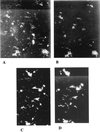Inhibition of Borrelia burgdorferi migration from the midgut to the salivary glands following feeding by ticks on OspC-immunized mice
- PMID: 10603419
- PMCID: PMC97152
- DOI: 10.1128/IAI.68.1.411-414.2000
Inhibition of Borrelia burgdorferi migration from the midgut to the salivary glands following feeding by ticks on OspC-immunized mice
Abstract
Borrelia burgdorferi-infected ticks were fed on either OspC-immunized mice or normal, nonimmunized mice. After 72 h, the ticks were detached, followed by dissection and subsequent culturing in Barbour-Stoenner-Kelley II medium of the salivary glands from each tick to determine the presence of borreliae. Forty percent (10 of 25) of salivary glands from ticks that had fed on nonimmunized mice were culture positive, while only 7.4% (2 of 27) of salivary glands from ticks that had fed on OspC-immunized mice were culture positive, thus indicating a much reduced borrelial migration from the midgut when the bloodmeal contained anti-OspC antibodies. Fluorescent antibody staining of the corresponding midguts from ticks that had fed on the OspC-immunized mice showed that borreliae were present but did not produce OspC. In contrast, borreliae in midguts from ticks that had fed on normal mice demonstrated substantial ospC expression. This study provides evidence that, during tick feeding on an OspC-immunized host, transmission of borreliae from the tick is prevented; it also suggests that OspC functions in a tick-to-host transmission mechanism.
Figures


Similar articles
-
Influence of outer surface protein A antibody on Borrelia burgdorferi within feeding ticks.Infect Immun. 1999 Jan;67(1):30-5. doi: 10.1128/IAI.67.1.30-35.1999. Infect Immun. 1999. PMID: 9864192 Free PMC article.
-
Borrelia burgdorferi OspA is an arthropod-specific transmission-blocking Lyme disease vaccine.J Exp Med. 1996 Jan 1;183(1):271-5. doi: 10.1084/jem.183.1.271. J Exp Med. 1996. PMID: 8551231 Free PMC article.
-
Complementation of a Borrelia afzelii OspC mutant highlights the crucial role of OspC for dissemination of Borrelia afzelii in Ixodes ricinus.Int J Med Microbiol. 2007 Apr;297(2):97-107. doi: 10.1016/j.ijmm.2006.11.003. Epub 2007 Jan 30. Int J Med Microbiol. 2007. PMID: 17267282
-
Vector interactions and molecular adaptations of lyme disease and relapsing fever spirochetes associated with transmission by ticks.Emerg Infect Dis. 2002 Feb;8(2):115-21. doi: 10.3201/eid0802.010198. Emerg Infect Dis. 2002. PMID: 11897061 Free PMC article. Review.
-
Immune evasion of Borrelia burgdorferi: insufficient killing of the pathogens by complement and antibody.Int J Med Microbiol. 2002 Jun;291 Suppl 33:141-6. doi: 10.1016/s1438-4221(02)80027-3. Int J Med Microbiol. 2002. PMID: 12141738 Review.
Cited by
-
The relapsing fever spirochete Borrelia hermsii contains multiple, antigen-encoding circular plasmids that are homologous to the cp32 plasmids of Lyme disease spirochetes.Infect Immun. 2000 Jul;68(7):3900-8. doi: 10.1128/IAI.68.7.3900-3908.2000. Infect Immun. 2000. PMID: 10858201 Free PMC article.
-
Characterization of Borrelia burgdorferi aggregates.Vector Borne Zoonotic Dis. 2009 Jun;9(3):323-9. doi: 10.1089/vbz.2008.0148. Vector Borne Zoonotic Dis. 2009. PMID: 19499997 Free PMC article.
-
Verification and dissection of the ospC operator by using flaB promoter as a reporter in Borrelia burgdorferi.Microb Pathog. 2008 Jul;45(1):70-8. doi: 10.1016/j.micpath.2008.03.002. Epub 2008 Mar 25. Microb Pathog. 2008. PMID: 18479884 Free PMC article.
-
Transgenic functional complementation with a transmission -associated protein restores spirochete infectivity by tick bite.Ticks Tick Borne Dis. 2020 May;11(3):101377. doi: 10.1016/j.ttbdis.2020.101377. Epub 2020 Jan 20. Ticks Tick Borne Dis. 2020. PMID: 32005628 Free PMC article.
-
Outer-surface protein C of the Lyme disease spirochete: a protein induced in ticks for infection of mammals.Proc Natl Acad Sci U S A. 2004 Mar 2;101(9):3142-7. doi: 10.1073/pnas.0306845101. Epub 2004 Feb 17. Proc Natl Acad Sci U S A. 2004. PMID: 14970347 Free PMC article.
References
-
- Benach J L, Coleman J L, Skinner R A, Bosler E M. Adult Ixodes dammini on rabbits: a hypothesis for the development and transmission of Borrelia burgdorferi. J Infect Dis. 1987;155:1300–1306. - PubMed
-
- Burgdorfer W, Barbour A G, Hayes S F, Benach J L, Grunwaldt E, Davis J P. Lyme disease—a tick-borne spirochetosis? Science. 1982;216:1317–1319. - PubMed
-
- Gern L, Zhu Z, Aeschlimann A. Development of Borrelia burgdorferi in Ixodes ricinus females during blood feeding. Ann Parasitol Hum Comp. 1990;65:89–93. - PubMed
MeSH terms
Substances
LinkOut - more resources
Full Text Sources
Other Literature Sources
Medical

